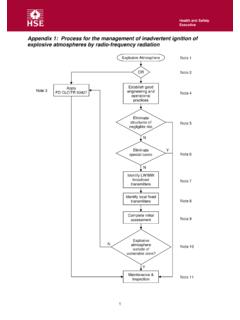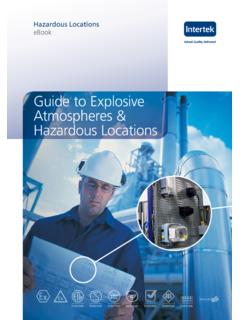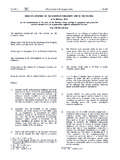Transcription of Global Reference Guide for Potentially Explosive ...
1 Class IDivision 1 Groups A, B, C & D T6 Class I Zone 1 AEx e IIC T6 NEC 500IP56II 2 G / DEx d e IIC T6 Gb/ Ex t IIIC T80 C DbeLLK : D1234562010 PTB09 ATEX12345110-240V50-60 HzII 2 G Ex de IIC T6 GbII 2 D Ex t IIIC T80 C DbIECEx BVS - 240 V DCTa= -25 C - +55 CLamp: G13 60081 IEC0102 TankZone 0 Zone 2 Zone 1brennbareFl ssigkeitZone 22 Zone 21 Zone 20brennbarer StaubNEC 505/ CEC 181)1) Global Reference Guide for Potentially Explosive Atmospheres and Hazardous LocationsIngress Protection Codes IP .. according IEC 60079 NEMA Enclosure TypesIngress Protection (IP) Codes and NEMA Enclosure TypesEnclosure Intended UseEquivalentTypeIP Rating*1 Indoor use, limited amounts of falling dirt203 Outdoor use, rain, sleet, windblown dust, external formation of ice553 ROutdoor use, rain, sleet, external formation of ice543 SOutdoor use, rain, sleet, windblown dust, external mechanisms operable when ice laden554 Indoor or outdoor use, windblown dust and rain, splashing water, hose directed water, external formation of ice564 XIndoor or outdoor use, windblown dust and rain, splashing water, hose directed water, corrosion, external formation of ice565 Indoor use.
2 Settling airborne dust, falling dirt, non-corrosive liquids536 Indoor or outdoor use, hose directed water, temporary submersion, external formation of ice676 PIndoor or outdoor use, hose directed water, prolonged submersion, external formation of ice687**Indoor use, Class I, Division 1, Groups A, B, C, and D hazardous locations, air-break equipment8**Indoor or outdoor use, Class I, Division 1 Groups A, B, C, and D hazardous locations, oil-immersed equipment9**Indoor use, Class II, Division 1, Groups E, F, and G hazardous locations, air-break equipment10**Mining applications12 Indoor use, circulating dust, falling dirt, dripping noncorrosive liquids5412 KIndoor use, circulating dust, falling dirt, dripping noncorrosive liquids, provided with knockouts5413 Indoor use, lint, dust, spraying of water, oil and noncorrosive coolant54* NEMA Enclosure Type can be converted to IP Code rating, but IP Codes cannot be converted to NEMA Enclosure Type (Ref.)
3 NEMA 250)** Enclosure Types for only (Ref. NEMA 250)FIRST NUMERALP rotection against solid bodies0 - NO PROTECTION1- OBJECTS EQUAL TOOR GREATER THAN 50 mm2 - OBJECTS EQUAL TOOR GREATER THAN mm3 - OBJECTS EQUAL TOOR GREATER THAN mm4 - OBJECTS EQUAL TOOR GREATER THAN mm5 - DUST-PROTECTED6 - DUST-TIGHTSECOND NUMERALP rotection against liquid0 - NO PROTECTION1 - VERTICALLY DRIPPING WATER2 - 75 TO 105 -ANGLED DRIPPING WATER3 - SPRAYING WATER4 - SPLASHING WATER5 - WATER JETS6 - HEAVY SEAS, POWERFUL WATER JETS7 - EFFECTS OF IMMERSION8 - INDEFINITE IMMERSIONT emperature ClassificationMaximum SurfaceIECNEC 500 -TemperatureNEC 505 Table (C)
4 450 C (842 F)T1T1300 C (572 F)T2T2280 C (536 F)T2A260 C (500 F)T2B230 C (446 F)T2C215 C (419 F)T2D200 C (392 F)T3T3180 C (356 F)T3A165 C (329 F)T3B160 C (320 F)T3C135 C (275 F)T4T4120 C (248 F)T4A100 C (212 F)T5T585 C (185 F)T6T6 ATEX / IEC ReferenceNEC / CEC ReferenceZone Classification / Equipment Protection LevelHazardous Period of presenceZoneNecessary Marking for the Equipmentmixtureof the flammableClassificationAccording 94/9/ECAccording IEC 60079-0substancesEquipment CategoryProtectionEquipmentProtectionGro upGroupProtectionLevelLevel EPLGasContinuously for longZone 0II1 GIIG avery highMistperiods or frequentlyVaporOccasional occurrenceZone 1II2 GIIG bhighNot likely.
5 But if it does occuronly rarely and for a short period Zone 2II3 GIIG cincreasedDustContinuously for longZone 20 III1 DIIID avery highperiods or frequentlyOccasional occurrenceZone 21 III2 DIIID bhighNot likely, but if it does occuronly rarely and for a short period Zone 22 III3 DIIID cincreasedMethaneMiningIM1 IMavery highCoal dustMiningIM2 IMbhighExplosion GroupsExplosiveTypicalExplosion GroupAtmospheres:Hazardous MaterialGases andAcetyleneIICV aporsHydrogenIIC or IIB+H2 EthyleneIIBP ropaneIIAD ustsMetal dustIIICCoal dustIIICG rain dustIIIBF ibresWood, paper,IIIA& Flyingsor cotton processingMethod of Explosion ProtectionElectrical Type of Protection for Atmospheres made Explosive by gases, vapors and mistsType of Protection Type of ProtectionZone/ ATEX Category/ EPLCENELEC /IEC StandardProtection Concept-General RequirementsEN 60079-0 / IEC 60079-0 -dFlameproof EnclosureZone 1 or 2/ 2 G/ GbEN 60079-1 / IEC 60079-1 Contain the explosion.
6 Prevent the flame propagationeIncreased SafetyZone 1 or 2/ 2 G/ GbEN 60079-7 / IEC 60079-7 No arcs, sparks or hot surfacesiaIntrinsic SafetyZone 0, 1 or 2 / 1G/ GaEN 60079-11 / IEC 60079-11 Limit the energy of the spark and the surface temperatureibIntrinsic SafetyZone 1 or 2/ 2 G/ GbEN 60079-11 / IEC 60079-11 Limit the energy of the spark and the surface temperatureicIntrinsic SafetyZone 2/ 3 G/ GcEN 60079-11 / IEC 60079-11 Limit the energy of the spark and the surface temperatureIntrinsically Safe SystemsZone 1 or 2/ 2 G/ GbEN 60079-25 / IEC 60079-25 Limit the energy of the spark and the surface temperatureIntrinsically Safe Fieldbus Systems (FISCO)
7 Zone 1 or 2/ 2 G/ GbEN60079-27 / IEC 60079-27 Limit the energy of the spark and the surface temperatureNon-sparking Fieldbus Systems (FNICO) Zone 1 or 2/ 3 G/ GcEN 60079-27 / IEC 60079-27 Limit the energy of the spark and the surface temperaturemaEncapsulationZone 0, 1 or 2 / 1 G/ GaEN 60079-18 / IEC 60079-18 Exclusion of Ex-atmospherembEncapsulationZone 1 or 2/ 2 G/ GbEN 60079-18 / IEC 60079-18 Exclusion of Ex-atmospheremcEncapsulationZone 2/ 3 G/ GcEN 60079-18 / IEC 60079-18 Exclusion of Ex-atmospherenANon-SparkingZone 2/ 3 G/ GcEN 60079-15 / IEC 60079-15 No arcs, sparks or hot surfacesnCEnclosed BreakZone 2/ 3 G/ GcEN 60079-15 / IEC 60079-15 Prevent the flame propagationnRRestricted BreathingZone 2/ 3 G/ GcEN 60079-15 / IEC 60079-15 Protection by enclosureoOil ImmersionZone 1 or 2/ 2 G/ GbEN 60079-6 / IEC 60079-6 Exclusion of Ex-atmosphereop is,Optical RadiationZone 0, 1 or 2 / 1 G, 2 G or 3 G / Ga, Gb, Gc EN 60079-28 / IEC 60079-28 Limit or prevent energy transmission from optical radiationop pr, op shOptical RadiationZone 1 or 2/ 2 G or 3 G/ Gb, GcEN 60079-28 / IEC 60079-28 Limit or prevent energy transmission from optical radiationpx.
8 PyPressurized EnclosureZone 1 or 2/ 2 G/ GbEN 60079-2 / IEC 60079-2 Exclusion of Ex-atmospherepzPressurized EnclosureZone 2/ 3 G/ GcEN 60079-2 / IEC 60079-2 Exclusion of Ex-atmosphereqPowder FillingZone 1 or 2/ 2 G/ GbEN 60079-5 / IEC 60079-5 Prevent the flame propagationElectrical Type of protection for Atmospheres made Explosive by dustsType of Protection Description of ProtectionATEX Zone/ ATEX Category/ EPLCENELEC /IEC StandardProtection Concept-General RequirementsEN 60079-0 / IEC 60079-0 -iaIntrinsic SafetyZone 20, 21, 22 / 1 D/ DaEN 61241-11 / IEC 61241-11 Limit the surface temperatureibIntrinsic SafetyZone 21, 22/ 2 D/ DbEN 61241-11 / IEC 61241-11 Limit the surface temperaturemaEncapsulationZone 20, 21, 22 / 1 D/ DaEN 60079-18 / IEC 60079-18 Exclusion of Ex-atmospherembEncapsulationZone 21 or 22 / 2 D/ DbEN 60079-18 / IEC 60079-18 Exclusion of Ex-atmospheremcEncapsulationZone 20, 21, 22 / 1 D/ DaEN 60079-18 / IEC 60079-18 Exclusion of Ex-atmospherepPressurizedZone 22/ 3 D/ DcEN 61241-4 / IEC 61241-4 Exclusion of Ex-atmospheretProtection by enclosureZone 20, 21, 22 / 1 D, 2 D or 3 D / Da, Db.
9 Dc EN 60079-31 / IEC 60079-31 Keep the combustible dust out and avoid hot surfacesMethod of Explosion ProtectionType ofDescriptionPermitted for use inProtectionProtection of ProtectionUnited StatesCanadaConceptNEC 500 NEC 505 CEC 18 CEC 18 Division ZoneDivision ZoneeIncreased Safety-1, 2-1, 2 No arcs, sparksnNon-Incendive2222or hot surfacesdFlameproof-1, 2-1, 2 Contain the explosion,-Explosionproof1, 2-1, 2-prevent the flameqPowder Filled-1, 2-1, 2 propagationiaIntrinsic Safety1, 20, 1, 21, 20, 1, 2 Limit the energy ofibIntrinsic Safety-1, 2-1, 2 the spark and thesurface temperaturepPressurized(Purged)1, 21, 21, 21, 2 Keep the flammablemEncapsulation-1, 2-1, 2 gas outoOil Immersion21, 221, 2 Hazardous Atmosphere Category (Gas or Dust Grouping)
10 ExplosiveTypicalNorth America NEC 500-503 / CEC 18 NEC 505*/CEC 18 AtmosphereHazard MaterialHazard CategoryGroupingGas GroupingGases andAcetyleneClass IGroup AIICV aporsHydrogenClass IGroup BIIC or IIB+H2 EthyleneClass IGroup CIIBP ropaneClass IGroup DIIAD ustsMetal dustClass IIGroup E-Coal dustClass IIGroup F-Grain dustClass IIGroup G-FibresWood, paper,Class III--& Flyingsor cotton processing* NEC 505 covers Explosive gases and vapors Protection MarkingEquipmentGroupEquipmentCategoryEx plosive Atmosphere Suitability(G Gas, vapor or mist) Explosive Atmosphere Suitability(D Dust)Explosion MarkingTypeof protection (Gas)Explosion Group (Gas)Temperature Class (Gas)Equipment Protection Level (EPL-Gas)Explosion Protection MarkingTypeof protection (Dust)Explosion Group (Dust)Max.








